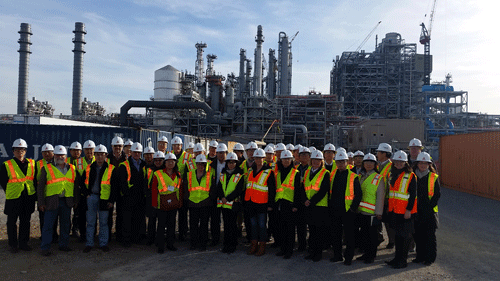 It was a pleasure to recently visit Southern Company’s Kemper County Energy Facility in Mississippi. This visit was as part of the delegation from the ISO TC265 meeting in Birmingham Alabama. The Integrated Gasification Combined Cycle (IGCC) plant construction is largely completed now, and commissioning of the plant and its integrated processes will take the rest of the year. Operated by Mississippi Power, it is planned to be fully in-service in the first half of 2016, when it will become the world’s second commercial-scale coal power CCS project (after SaskPower’s Boundary Dam) and the world’s first based on IGCC technology.
It was a pleasure to recently visit Southern Company’s Kemper County Energy Facility in Mississippi. This visit was as part of the delegation from the ISO TC265 meeting in Birmingham Alabama. The Integrated Gasification Combined Cycle (IGCC) plant construction is largely completed now, and commissioning of the plant and its integrated processes will take the rest of the year. Operated by Mississippi Power, it is planned to be fully in-service in the first half of 2016, when it will become the world’s second commercial-scale coal power CCS project (after SaskPower’s Boundary Dam) and the world’s first based on IGCC technology.
Visually the plant is striking for its size and complexity. It takes a lot of space to fit two gasifiers, lignite handling and dryers, CO2 capture processes (using water gas shift and Selexol solvent), a sulphuric acid plant, an ammonia plant, two gas turbines, two heat recovery steam generators, a steam turbine, and a nitrogen plant. At the core of it is the transport gasification technology (TRIGTM) which was developed by Southern Company, KBR and US DOE, and uses a fuel recycling process that is suitable for low grade fuels such as lignite.
As an IGCC, this is a polygeneration facility, not just a power plant. It will produce and sell 582 MW of electricity, 3 million tonnes pa of CO2, 135,000 tonnes pa of sulphuric acid and 20,000 tonnes pa of anhydrous ammonia. It is immediately next to a dedicated open cast lignite mine operated by Liberty Fuels, which lowers the fuel cost. The plant will capture at least 65% of the CO2 and pipe 3 million tonnes per year to Denbury for use in CO2 EOR via its Green Pipeline. It will use waste water from the town of Meridian and from the lignite drying, and it is a zero liquid discharge site. It is multi-fuel also, as it can run on natural gas instead of the syngas, in which case output increases to 730 MWe. Whilst the capital costs are significant, it should be remembered that this is a first-of-its-kind full-scale demonstration plant, and the operating costs are expected to be competitive over its lifetime due to the low cost fuel. The plant has brought much employment to the area, some 12,000 jobs during construction and more than 1,000 permanent jobs.
It is also of interest to those of us from the UK that the Liberty Fuels mine has a massive dragline crane to remove the overburden and expose the lignite bed. This 4000 tonne giant with a 100m boom was shipped over from Northumberland UK, where it was the largest dragline in Western Europe and was famously known as the ‘Ace of Spades’. The local school children at Kemper have appropriately renamed it ‘Liberty Belle’.
So many aspects of this commercial-scale power- and chemical- plant are of interest, it is already providing a lot of learnings for those involved in it, and even more for the CCS world to look forward to when operational next year. Many thanks to Bruce Harrington and Lee Youngblood of Mississippi Power for hosting the visit, and to Richard Esposito of Southern Company and Steve Carpenter of ARI for organising the trip.
 Photo courtesy of Richard Esposito
Photo courtesy of Richard Esposito


